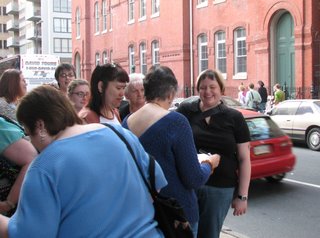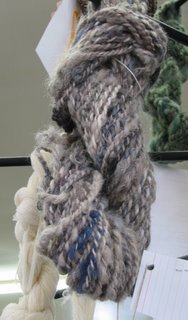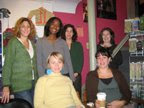I find a similar project with known yardage requirements, and work from there.
In this case, I wanted half-fingered gloves. I couldn't find a pattern for them, but I did know that these

take one skein of Virtue, which is about 75 yards.
From there, I knew I'd have to add yardage for the fingers. I also knew I'd have to revise the yardage estimate upward, because the gauntlets were knit at a gauge of 5 sts per inch, and I was planning to knit the knew gloves at 5.5 or 6 sts per inch--and the same project knit at a smaller gauge requires more yardage. A 40" sweater at 3 sts per inch takes 800+ yards; at 6 sts per inch, over 2000.
I still felt pretty confident with my 200 yards. But just to be safe, I planned my knitting around the limited supply. Here are the principles I use for yarn-efficient knitting:
1. If the project has several of something, they should be done first (or at least, early. If you're going to run out of yarn, it shouldn't be after the 7th finger of a pair of gloves.
2. If the project has two of something, they should be done together. Both sleeves, both socks, whatever. In the case of the gauntlets pictured above, I used two sets of needles and worked one from the outside of the ball and one from the inside. When I started to get near the end of the ball, I'd work one round on the first gauntlet, then one round on the other, to make sure they came out even.
3. Failing that, divide the yarn in half. You may remember seeing this picture

and wondering why there were three balls, since I kept talking about measuring two bobbins' worth and counting two skeins' worth. It's because I divided the yarn before I took the picture: I'd established that my two skeins were uneven, so, when I would the larger one, I separated it into two pieces in such a way that the smaller one plus the other skein would equal the larger one. (How? I already knew how many strands or loops there were in each skein. I tied something bright to one spoke of the swift and counted how many times it flew by; one revolution = one loop.)
4. Decide where length is expendable. Sometimes it's the sleeves of a sweater, sometimes it's the length; usually, it's the leg of a sock. In this case, it was (pretty obviously) the cuff.
5. Do that part last. That way, you can go until the yarn runs out, then stop. This is why top-down sweaters are considered so yarn-efficient, and it's one of the great reasons to do socks from the toe up.
According to these rules, I'd want to start by making all the mini-fingers of my gloves, then do the hand, and finish with the cuff. And there are ways to make gloves from fingertip to cuff; for one, see Latvian Dreams.
But working the fingers from the top down doesn't facilitate gussets between the fingers, and I love gussets between the fingers. (You know what a gusset is, right? It's a triangular section of fabric that eases the stress where several corners meet.) They prevent gaps where the fingers meet each other and the hand, improve the fit, and save wear and tear on the fabric.
So how do you knit the fingers from bottom to top, but the cuff from palm toward elbow? As I'm writing this, I considered the word "wrist" in that sentence instead of the word "palm," and "wrist" would have been a better choice: not just for the sentence, but for the project. But what I did instead was to use my favorite provisional cast-on (the one where you crochet a chain out of waste yarn, then pick up sts through the bumps on the underside) to cast on 38 sts. That was the spot just above where the thumb would split off. I began knitting in the round for the upper area of the palm, decreasing two sts after 1 round (for a tiny gusset above what would become the thumb opening).
From there, I made half-fingered gloves as usual:

Then, I went back to the palm and undid the provisional cast-on and worked down from there. This meant that, almost immediately, I needed to work a thumb gusset in reverse: I put a few sts on a holder at the thumb spot, used a provisional cast-on again to cast on about 12 sts in the gap, and then gradually decreased the 12 sts down to 2 in the usual way. (In this case, I think it was "Dec 1 st each side every third round 3 times then every 4th round 2 times.")
Soon after the thumb gusset was done, it was time for the cuff. I used a 1x1 ribbing, just because I always do 2x2 and I was bored.
By this time, it was more than apparent that my yarn supply was going to hold out. In fact, I had started with the smallest ball, and I hadn't finished it yet. I ribbed as long as I wanted to, but it seemed silly to go to the elbow just for the sake of using up the yarn, so I stopped. Then I retrieved the stitches from the holder and cast-on at the thumb, worked a few rounds, and called it a day.
I repeated the same procedure (more or less--the first glove wasn't with me when I got to the thumb opening of the second, and I forgot that I'd done a provisional cast-on at that point, so I used a cable cast-on, and then picked up stitches when it was time to finish the thumb) once more.
Now I have gloves
and two balls of leftover yarn (one about 100 yards, one much less). The fit of the gloves isn't perfect (a little baggy in the palm--next time, I'm going to try a few shortrows along the back, as in the Fiber Trends felted mitten pattern), but I like the color effect very much: the strange earthy tones and the random (!) distribution make it all look very organic to me, like moss growing over rocks maybe.


















